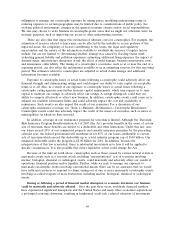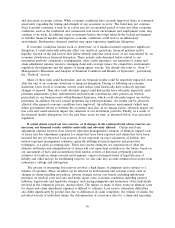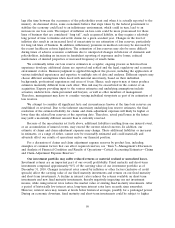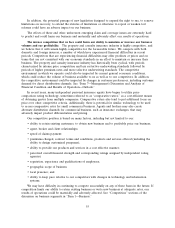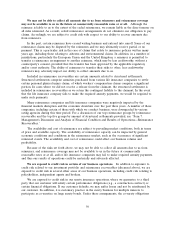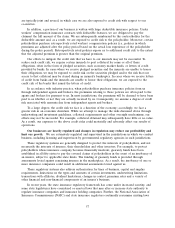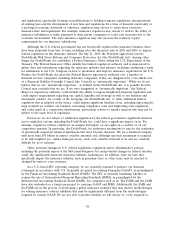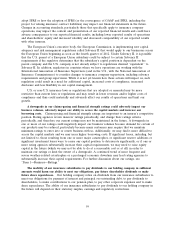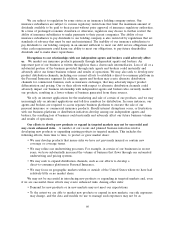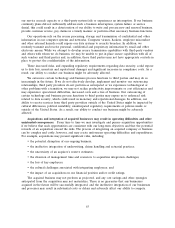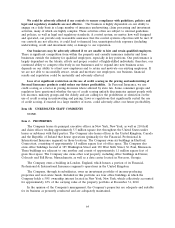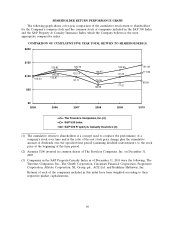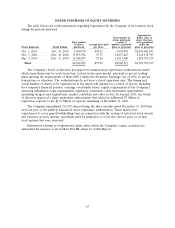Travelers 2010 Annual Report Download - page 70
Download and view the complete annual report
Please find page 70 of the 2010 Travelers annual report below. You can navigate through the pages in the report by either clicking on the pages listed below, or by using the keyword search tool below to find specific information within the annual report.and regulations, specifically focusing on modifications to holding company regulations, interpretations
of existing laws and the development of new laws and regulations. In a time of financial uncertainty or
a prolonged economic downturn or otherwise, regulators may choose to adopt more restrictive
insurance laws and regulations. For example, insurance regulators may choose to restrict the ability of
insurance subsidiaries to make payments to their parent companies or reject rate increases due to the
economic environment. The state insurance regulators may also increase the statutory capital
requirements for our insurance subsidiaries.
Although the U.S. federal government has not historically regulated the insurance business, there
have been proposals from time to time, including after the financial crisis in 2008 and 2009, to impose
federal regulation on the insurance industry. On July 21, 2010, the President signed into law the
Dodd-Frank Wall Street Reform and Consumer Protection Act (the Dodd-Frank Act). Among other
things, the Dodd-Frank Act establishes a Federal Insurance Office within the U.S. Department of the
Treasury. The Federal Insurance Office initially has limited regulatory authority and is empowered to
gather data and information regarding the insurance industry and insurers, including conducting a study
for submission to the U.S. Congress on how to modernize and improve insurance regulation in the U.S.
Further, the Dodd-Frank Act gives the Federal Reserve supervisory authority over a number of
financial services companies, including insurance companies, if they are designated by a two-thirds vote
of a Financial Stability Oversight Council (the Council) as ‘‘systemically important.’’ While we do not
believe that we are ‘‘systemically important,’’ as defined in the Dodd-Frank Act, it is possible that the
Council may conclude that we are. If we were designated as ‘‘systemically important,’’ the Federal
Reserve’s supervisory authority could include the ability to impose heightened financial regulation and
could impact requirements regarding our capital, liquidity and leverage as well as our business and
investment conduct. As a result of the foregoing, the Dodd-Frank Act, or other additional federal
regulation that is adopted in the future, could impose significant burdens on us, including impacting the
ways in which we conduct our business, increasing compliance costs and duplicating state regulation,
and could result in a competitive disadvantage, particularly relative to smaller insurers who may not be
subject to the same level of regulation.
Even if we are not subject to additional regulation by the federal government, significant financial
sector regulatory reform, including the Dodd-Frank Act, could have a significant impact on us. For
example, regulatory reform could have an unexpected impact on our rights as a creditor or on our
competitive position. In particular, the Dodd-Frank Act authorizes assessments to pay for the resolution
of systemically important financial institutions that have become insolvent. We (as a financial company
with more than $50 billion in assets) could be assessed, and, although any such assessment is required
to be risk weighted (i.e., riskier firms pay more), such costs could be material to us and are currently
difficult for us to estimate.
Other potential changes in U.S. federal legislation, regulation and/or administrative policies,
including the potential repeal of the McCarran-Ferguson Act and potential changes in federal taxation,
could also significantly harm the insurance industry, including us. In addition, state tax laws that
specifically impact the insurance industry, such as premium taxes or other taxes, may be enacted or
changed by states to raise revenues.
As a U.S.-based SEC reporting company, we are currently required to prepare our financial
statements in accordance with U.S. Generally Accepted Accounting Principles (GAAP), as promulgated
by the Financial Accounting Standards Board (FASB). The SEC is currently examining whether to
require the use of International Financial Reporting Standards (IFRS), as promulgated by the
International Accounting Standards Board (IASB), for companies such as us. The FASB and the IASB
have also embarked on a long-term project to converge GAAP and IFRS. Additionally, the IASB and
the FASB are in the process of developing a global insurance standard that may involve methodologies
for valuing insurance contract liabilities that may be significantly different from the methodologies
required by current GAAP. We are not able to predict whether we will choose to, or be required to,
58


